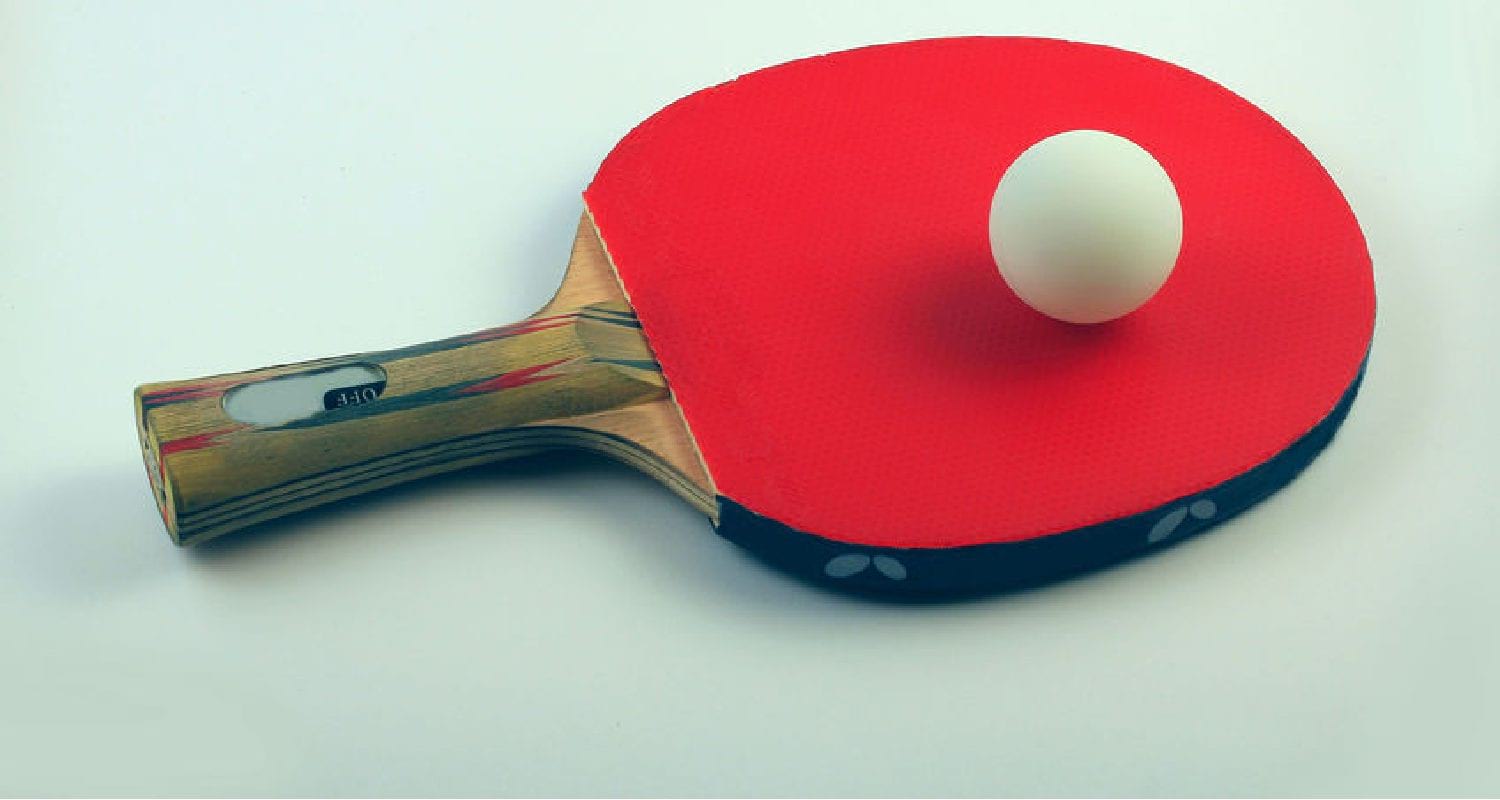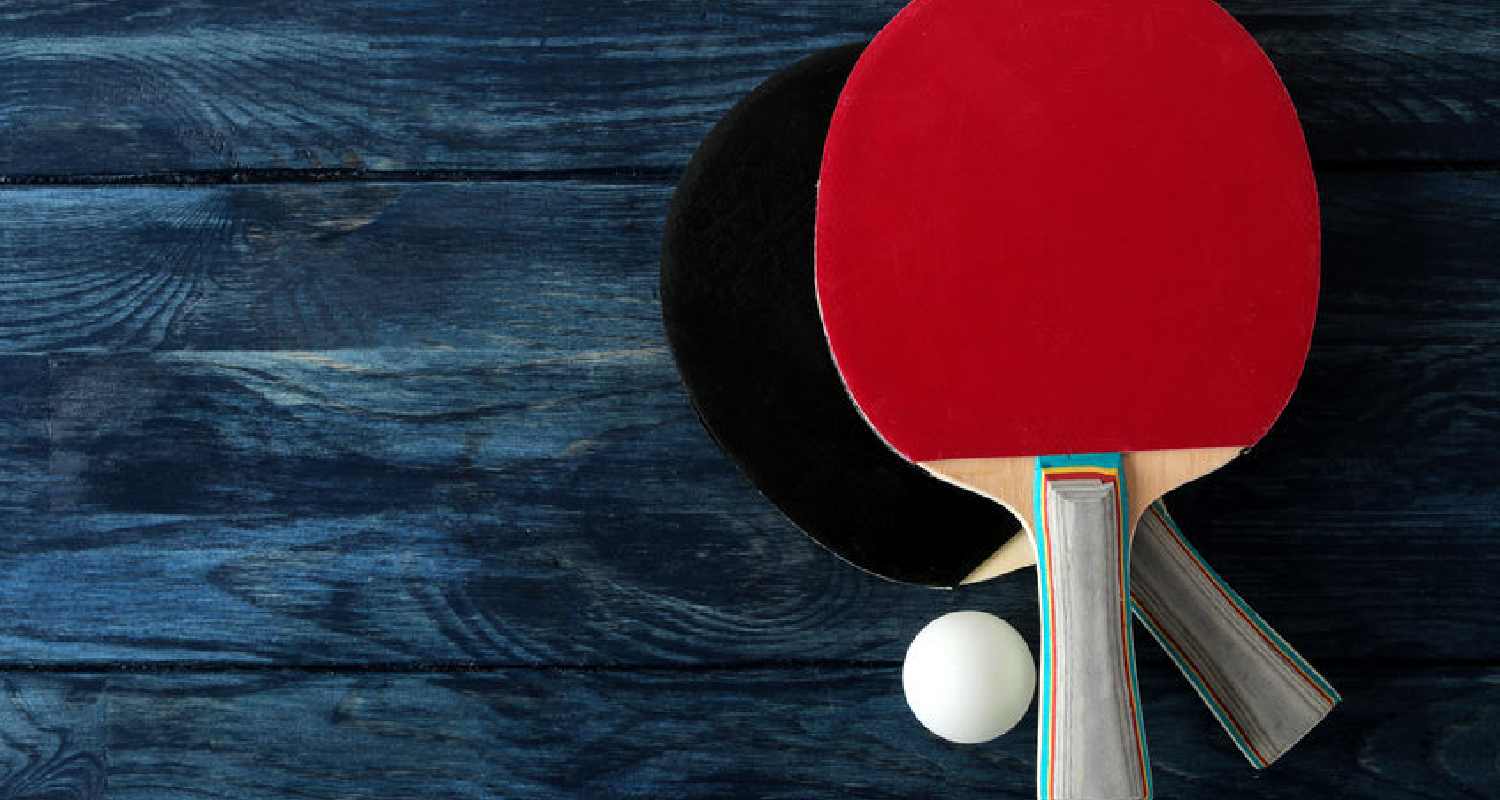If you truly love playing ping pong, you will realize how important it is to change the rubber of your ping pong paddle. Replacing the rubber can have a big impact on your game, as well, yet, many players do not know how to replace table tennis rubber. Not to worry, though, we have you covered with all the information you could need!
Table of Contents
Parts of the Paddle
Before changing the rubber on your paddle, you should know what makes up your ping pong paddle. This will help you in knowing which parts can be replaced. In general, there are three basic parts to a ping pong paddle and they are as following:
Blade
The most important part of the paddle is the blade. When we refer to the blade, we include the handle as well as the “head” of the paddle. This part of the paddle is usually made of wood, and/or carbon fiber, and the weight along with feel is what distinguishes the two types.
Sponge
This is the first layer right after the blade, and it is on both sides of the paddle. The thicker the sponge, the more offensive you can play with your paddle as it adds more strength to the shots. A thinner sponge results in higher control and consequently defensive shots.
Rubber
This is the outermost layer of the paddle and this is a layer, along with the sponge, that we can change. There are three common types of rubbers in ping pong; inverted (smooth), long pips, short pips. All three have a different impact on the gameplay, which we have explained here. We’ve also compiled some of the best rubbers to choose from if you’re unsure.
Inverted Rubber
Inverted rubber is the most commonly used rubber in the world. This is a modern-styled rubber for aggressive players and has the most spin potential. It is also ideal for accommodating all-round play, making it a popular choice amongst players of all levels.
Long Pips
Long pips have extra-long pips protruding from the rubber. The way it is used in the play is by counteracting and reversing the spin of the opponent. The longer pips also enact unpredictability in their spin, making the table tennis ball “wobble” and altering its trajectory.
Short Pips
Short pips are usually have used in close-to-table and reactive counter-play styles. This is because it generates a lot less spin than a smooth surface rubber and also does well in absorbing spin. It can be used for a defensive playstyle and is known primarily for bringing back the old-fashioned “classic” play of the pre-spin table tennis.
Your sponge and rubber need replacing over time. Now that we know what makes a table tennis paddle, we can get to the part of replacing it.

Tools Required To Replace Paddle Rubber
Here are some of the things you will need to replace your paddle’s rubber:
Paddle With Replaceable Rubber
Some paddles come with permanent rubbers. These rubbers are usually made for beginners and they are not meant to be changed. Other paddles have the provision for changing the rubber, so before you think about changing the rubber, it is important to make sure that your paddle has this provision.
New Rubber
Of course, you will need new rubbers to replace the old ones on your paddle. Make sure the new ones are in line with how you play, and you are not changing it for the sake of changing the rubber. For example, if you have and defensive playing style, it does not make sense to invest in inverted rubbers, and vice versa.
Glue
Remember, you cannot replace the rubber with just any glue in the market. The glue should be designed specifically for sticking ping pong rubber. We suggest opting for the Butterfly Free Chack Racket Glue, as it is a reliable option for replacing all kinds of rubbers.
Applicator/Sponge
You will require an applicator to apply the glue on the blade. Usually, the applicator comes along with the glue and you do not need to buy it separately.
Rolling Pin/Hard Brayer
A rolling pin or a hard brayer is crucial in helping the rubber stay where it is supposed to be. We suggest getting it, rather than using anything else to “fix” the rubber. It helps in releasing the air pockets that can form underneath the rubber.
Scissors
For changing the rubber, you will require a sharp pair of scissors. People often enquire about the type of scissors required for changing the rubber. We suggest using a pair of scissors that is sharp, or a utility knife if you know how to use it.
Edge Tape
This is an optional item, as not everyone likes to use edge tape. I personally like it for the aesthetics, but it really is down to a person’s preference, whether or not they like the edge tape on their paddle. Narrow edge tape covers only the wooden part of the bat, wider ones cover the wood, as well as, the edge of the rubber.

How to Replace Table Tennis Rubber
Now that you have all the required items, we should get straight to the procedure of replacing your table tennis rubber.
Step 1
The first step is taking off the old rubber. This should be done very carefully! It requires a lot of patience, as you need to gently peel the rubber off the blade.
Remember, your motion should be peeling, not ripping. Also, you should be careful to apply even force to take it off.
Step 2
Once you have taken off the old rubber, you should take a long hard look at the surface of the blade. This will give you a better idea of the condition your paddle is in, and you should use this opportunity to clean the surface and make it smooth. Make sure there isn’t any residue glue left, and if there is, you can use soft sandpaper to gently scrub it off.
Step 3
After cleaning your blade, the next step is applying glue to one side of the new rubber that you have. Make sure it is a thin layer of glue and is spread evenly across the rubber. While you wait for the glue to sit, you should apply another thin layer, this time on the surface of the blade.
You can use a sponge or an applicator to evenly spread the glue on both surfaces. Take your sweet time in the application of glue and ensuring that the glue is spread evenly.
Step 4
The hardest part comes now. This is called the waiting step. You need to wait while the glue dries on both surfaces until it is tacky and sticky but not wet.
The rubber takes around 5-10 minutes and the blade will require 3-8 minutes, but remember to read the instructions.
Step 5
The next step is lining up the bottom corner of the rubber with the bottom corner of the blade. Although, if your rubber has a logo, make sure it is in the center over the bottom of the blade. This can be done by curling the upper side of the rubber away from the surface and pressing the bottom edge of the rubber on the paddle.
Step 6
Once you have the bottom edge of the rubber on the paddle, you unroll the rubber slowly on the surface of the blade. Make sure to prevent air bubbles from forming underneath. You can smoothen the new rubber into place and press it, using a rolling pin or a hard brayer.
Step 7
A craft knife comes in use, next. You use it to trim the edges of the rubber down the side of the blade. This needs to be done, neatly, as it will apply the rubber smoothly on the paddle blade.
Step 8
You do the same for the backside of the paddle and apply the rubber, there, in the same exact order. When you are done with all of this, you place the edge tape on the sides, giving it a nice and smooth finish.

When to Replace Your Paddle’s Rubber
Replacing the rubber on your table tennis paddle depends on how much you use your paddle, and how good/bad is the quality of your paddle. The rubber and sponge layers that make up the rubber on a table tennis paddle over time begin to wear out. If there are some spots on the surface or if there is a spot that is not as firm or the bounce and spin are inconsistent or different, it means you should replace your rubbers.
You can also replace the rubber if you feel there is a drop in performance or if there is any sign of damage. At the same time, casual table tennis players can even go more than a year without replacing the rubber and it will still serve them right.
Every manufacturer has a separate lifespan that they attach to their rubbers. On average, a rubber lasts around 50-90 playing hours, but most players tend to change their rubbers over a year. However, short pimples and anti-spin rubbers last longer than others.
Frequently Asked Questions
These are some queries people often have when it comes to replacing rubbers.
How often should you change the rubber on your table tennis bat?
As explained above, rubbers need replacing after a few months. On average, a good rubber can give you around 60-90 playing hours. You could also use it for around a year, and that could be more than enough time before you decide to replace it.
Can you replace premade table tennis bat rubber?
Yes, the premade table tennis bat rubber can be replaced. However, it is much more difficult to do so. It will require more care and you will have to be extra careful not to damage the bat.
How to preserve and maintain table tennis rubber?
Table tennis rubber attracts a lot of dust and that will lead to rubbers getting deteriorated in quality. Preserving and maintaining table tennis rubber is quite easy. You should make sure that you clean the rubber twice a week.
How to soften and stretch out table tennis rubber?
You can use the roller to stretch out the table tennis rubber. As for softening the table tennis rubber, that is not recommended. This is because first of all it is not possible to soften it, and even if you do so, it will not provide the wanted effect.
How long should you press the table tennis rubber?
You should press the table tennis rubber for as long as it requires to get it evenly stuck on the paddle head. It does not take a lot of time.
What is the catapult effect in table tennis?
The catapult effect refers to the speed of the racket. It refers to the rubber being stretched enough which means there is more tension in the rubber that makes it go faster.
Conclusion
If you replace your table tennis rubber, it allows you to keep using the paddle and you only need to change the rubber. This is the best way of getting maximum value out of your equipment and keep your game at its best. It also increases the life of your paddle, and paddles can be quite expensive.
We added a step by step procedure that will help you in replacing the rubber of your ping pong paddle with ease. Make sure you have all the needed equipment before you do it, and it helps to get visual aid, too. At the same time, we suggest following our instructions carefully, especially when you have to take the rubber off the paddle head.
At the same time, it is very important to remember that not every rubber can be replaced. Some rubbers cannot be taken off as they are designed for beginners. So, if you are a beginner, do check if your paddle has a replaceable rubber or not. Let us know if you have any questions regarding the procedure, we would be elated to help you!



